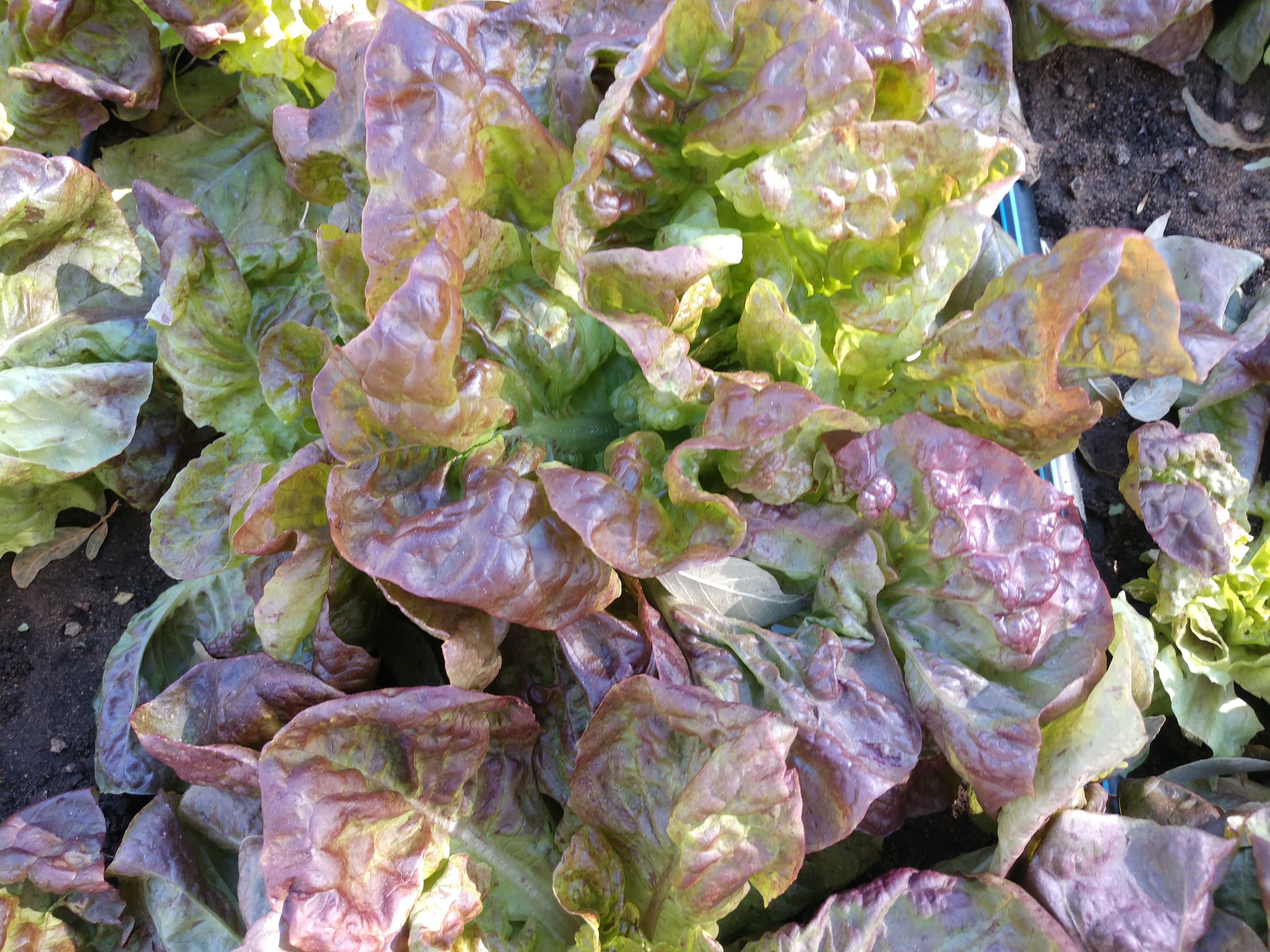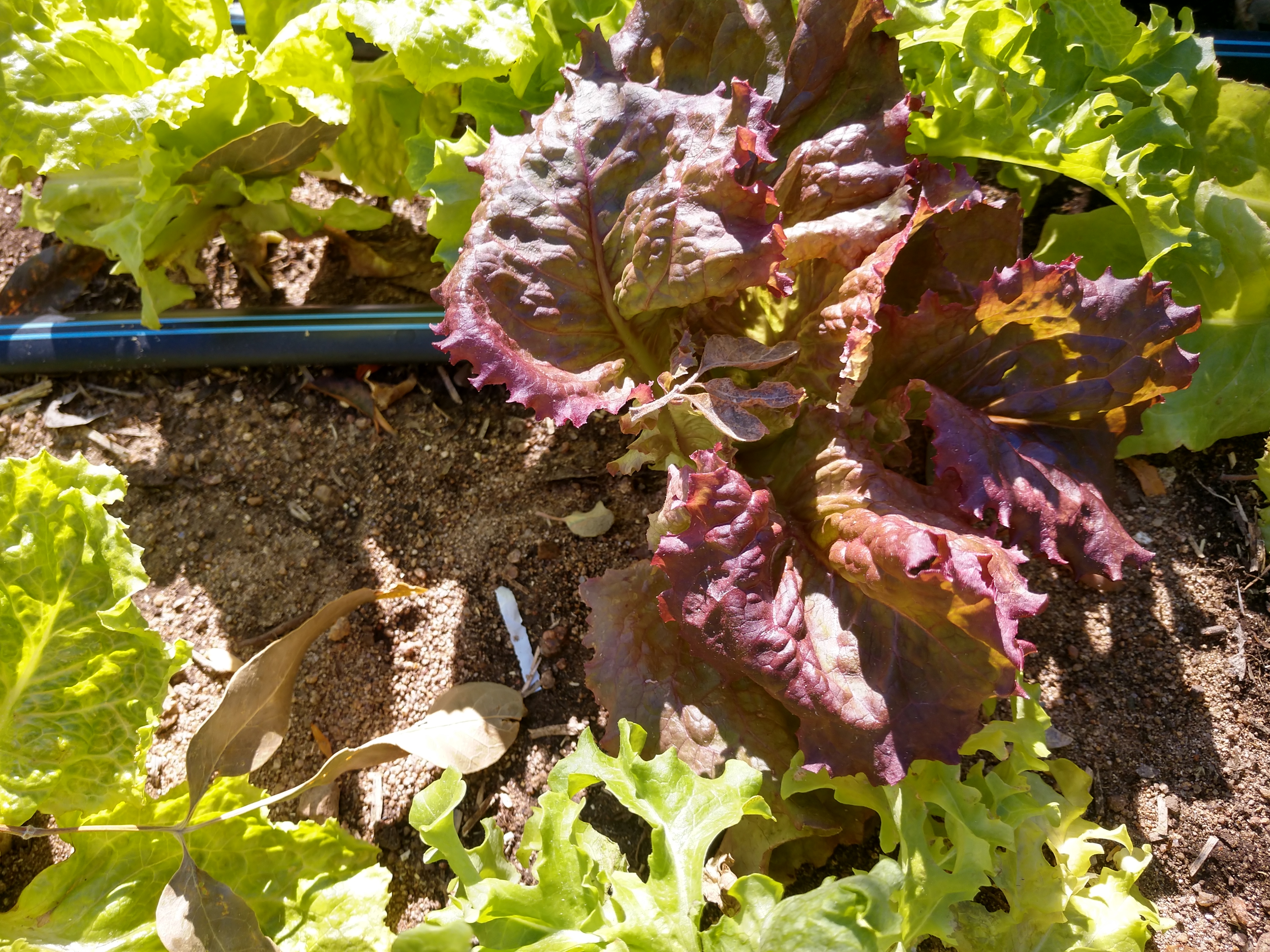 Winter Lettuce in the Home Garden - November 18, 2020 Jeff Schalau, Agent, Agriculture & Natural Resources University of Arizona Cooperative Extension, Yavapai County Cool season crops include garlic, onions, broccoli, cauliflower, Brussel’s sprouts, cabbage, kale, lettuce, and many others. They can also be grown outdoors during winter months below 5,000 feet (even higher if you use a cold frame or other frost protection strategies). In many ways, it is easier in winter because there are fewer insect pests and lower water demands during the cool weather. I grow lettuce year-round to have fresh salad greens. I live in Prescott, above 5,500 feet, and use frost protection strategies to protect young lettuce plants during the winter months. My frost protection has evolved over time and I now use low tunnels fitted with floating row cover for even greater frost protection. The August 19, 2020 Backyard Gardener discusses building low tunnels in detail Lettuces come in many shapes, sizes, and flavors. Most home gardeners grow loose-leaf types. Below, I have provided a general overview of major lettuce categories. Crisphead or Iceberg lettuces have a tight, firm heads of crisp, light green leaves with a white, densely packed heart. These types do not do well in hot summer conditions, and water or nutritional stress at any time of growth tends to result in premature bolting and poor growth. These take about 80 days to develop densely packed heads. I don’t recommend them for home garden because they are not as flavorful and can be purchased year-round from grocery stores. Summer Crisp, French Crisp or Batavian are intermediate between Crisphead and Looseleaf lettuce and tend to be large lettuces. Most varieties are resistant to bolting and have good flavor. The outer leaves are thick and crisp and can be harvested as a looseleaf until the head starts to form. The heart is crisp, juicy and sweet with a slight nutty flavor. Varieties tend to mature in about 55 to 60 days. Butterhead (also called Boston or Bibb) is a type of popular lettuce grown in Europe. The name comes from the buttery feel and creamy color of the inside leaves. The outer leaves are large and ruffled, often loosely folded, and darker green or brownish in color. Butterhead varieties can be harvested by removing outer leaves or by harvesting the entire head. Butterhead varieties are easier to grow than Crisphead types as they are more tolerant of various soil and weather conditions. Varieties are also rarely bitter in flavor, slow bolting, and mature in 55 days. Romaine or Cos lettuce is of Mediterranean origin and the names are interchangeable. “Romaine” is a derivation of Roman, while “Cos” comes from Kos, the Greek island. Romaine-type lettuces are 8 – 10 inches tall, upright in form, with long tightly folded leaves that are spoon shaped with thick midribs. Outer leaves are medium-green in color while inner leaves are greenish-white. Outer leaves can be a bit tough, but the ribs are tender and crunchy. Varieties tend to mature in about 75 days. Looseleaf lettuces are the easiest kinds of lettuce to grow in home gardens and they form no heart or head as the name indicates. They can be harvested leaf by leaf or by the whole plant. Leaves come in a wide variety of shapes and colors including thick, thin, savoyed, flat, red, green, frilled, cut, curled, wavy, crinkly and so on. There are some extremely frilly and decorative varieties. The leaves are tender, delicate, and mild flavored, and plants are slow bolting throughout the summer. Varieties tend to mature in 30 – 55 days. As you can see, lettuce types and varieties are interesting and have cultural histories and geographic names. Some of my recent favorites have been ‘Yugoslavian Red’, ‘Australian Yellowleaf’, ‘Red Velvet’, and ‘Goldrush’. All are loose-leaf types except for the Yugoslavian Red which is a butterhead type. Lettuces prefer well-drained soils that are fertile and amended with organic matter. I prefer to direct seed lettuce about ¼ inch deep in raised beds (rather than rows) and often mix different varieties in the same area. Once germinated and one inch tall, lettuce plants are usually tolerant of freezing temperatures. The photos included were following a 21 degree F overnight low. Lettuce can be easily transplanted to the desired density when the have 2 or 3 leaves. Thinned plants can be used for salads too. Winter lettuce will require irrigation when precipitation is lacking. For additional information and photos, visit the on-line edition of this column (see URL below). You can follow the Backyard Gardener on Twitter – use the link on the BYG website. If you have other gardening questions, email the Master Gardener Help Desk in Prescott (prescottmg@gmail.com) or Camp Verde (verdevalleymg@gmail.com) and be sure to include your name, location, and phone number. Find past Backyard Gardener columns or provide feedback at the Backyard Gardener web site: https://cals.arizona.edu/yavapai/anr/hort/byg/. Images  'Yugoslavian Red' is a butterhead lettuce that performs well during winter. It has a mild flavor and smooth texture. It was planted on August 21 and photographed on November 10, 2020.Photo by Jeff Schalau, University of Arizona.
'Yugoslavian Red' is a butterhead lettuce that performs well during winter. It has a mild flavor and smooth texture. It was planted on August 21 and photographed on November 10, 2020.Photo by Jeff Schalau, University of Arizona. 'Goldrush' is a looseleaf lettuce with frilly, bright green leaves. It is suitable for summer growing as it is slow to bolt. It was planted on August 21 and photographed on November 10, 2020. Photo by Jeff Schalau, University of Arizona.
'Goldrush' is a looseleaf lettuce with frilly, bright green leaves. It is suitable for summer growing as it is slow to bolt. It was planted on August 21 and photographed on November 10, 2020. Photo by Jeff Schalau, University of Arizona. 'Red Velvet' is a looseleaf lettuce with dark maroon to greenish-bronze colored leaves with a nice chewy texture. It is suitable for summer growing as it is slow to bolt but also becomes bitter when grown in hot weather. It was planted on August 21 and photographed on November 10, 2020. Photo by Jeff Schalau, University of Arizona
'Red Velvet' is a looseleaf lettuce with dark maroon to greenish-bronze colored leaves with a nice chewy texture. It is suitable for summer growing as it is slow to bolt but also becomes bitter when grown in hot weather. It was planted on August 21 and photographed on November 10, 2020. Photo by Jeff Schalau, University of Arizona 'Australian Yellowleaf' is a looseleaf lettuce with yellow-green leaves, soft texture, and large yields. It is often in mixes for baby greens. It was planted on October 10 and photographed on November 10, 2020. Photo by Jeff Schalau, University of Arizona
'Australian Yellowleaf' is a looseleaf lettuce with yellow-green leaves, soft texture, and large yields. It is often in mixes for baby greens. It was planted on October 10 and photographed on November 10, 2020. Photo by Jeff Schalau, University of ArizonaAdditional Resources Winter Lettuce, Washington State University agsyst.wsu.edu/WinterLettuce.html Lettuce in the Garden, Utah State University Extension utahpests.usu.edu/ipm/ornamental-pest-guide/weeds/w_siberian-elm Lettuce, University of Maryland Extension extension.umd.edu/hgic/topics/lettuce |